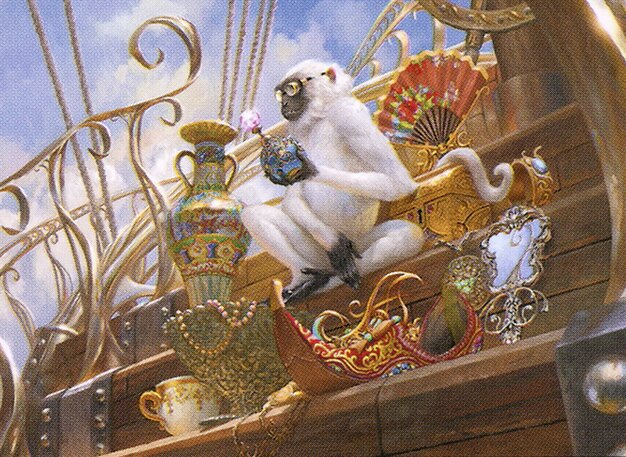 Art by Simon Dominic
Art by Simon DominicA somewhat typical vintage cube without the extended power 9. Trying to support combo, aggro, midrange and control in at least a somewhat balanced manner. There are a handful of supported archetypes, but I want there to be possibilities for emergent archetypes and deck strategies.
 Aggro
Aggro 
Red and white aggressive decks are a classic cube archetype. They win the game by being faster than the opponent, killing them before they get a chance to fully develop their gameplan. Practically this means that the core of an aggro deck is always cheap creatures, especially in the one and two mana slot.
When playing an aggressive deck you want to avoid struggles with mana colors as much as possible and always spend all your mana early on in the game. The power of aggro comes from consistently pressuring your opponent early on in the game and not as much from pure card quality. Getting manascrewed early on and losing that all important pressure because you couldn't play your threats can torpedo your chances of winning in an instant. Drew Hoyt has a great probabilistic write-up about the inconsistency of two-color aggro, and if you want to go down that rabbit hole, it's a great resource for crafting "competitively consistent" draft decks: https://medium.com/@drewjhoyt/probabilistic-magic-inconsistency-of-two-color-aggro-in-cube-c90690dc9d11
Similarly, while Ragavan is a much better 1-drop than Falkenrath Pit Fighter, you'd rather just play any creature with power and toughness on turn one so that you can start pressuring on early on.
TL,DR: Quantity over quality. Try to play only one color if at all possible.
While the core of red and white aggressive decks are similar, they do function slightly differently in gameplay. Red is the faster deck of the two, supporting it's early creatures with burn to act as removal and damage to the face (eg. 1, 2, 3)
White decks on the other hand don't have access to burn spells to finish off their opponent and need to use their creatures from start to finish. This isn't as big of an issue as it might seem as white creatures tend to be very powerful in combat or provide strong utility (1, 2).
Example decks:
Mono Red. A classic mono red aggressive deck with a pile of 1-drops supported by a chock full of burn.
White Weenie. An almost ideal White aggressive deck. A load of creatures supported by powerful removal spells and equipment.
 Aristocrats
Aristocrats 
Aristocrats is the name of an old standard deck from roughly 2013-2014 named after two mainstay creatures of the deck, Cartel Aristocrat and Falkenrath Aristocrat. It was essentially a deck where you would play a load of cheap creatures and tokens and sacrifice them yourself for some benefit. From there the aristocrats name caught on and became synonymous with any deck who's main gameplan is to sacrifice it's own creatures for some sort of benefit and aristocrats in my cube is no different. The black aristocrats decks play cheap and easy to recur creatures with the idea of sacrificing them for damage, cards or some other benefit. While the primary aristocrats color is black, monocolour aristocrats decks are very rare as the benefits of going into a second color are quite large, especially red. Cards like Goblin Bombardment and Mayhem Devil provide powerful benefits to aristocrats style decks.
An aristocrats deck typically have to play individually weak cards that become monstrously threatening when combined with synergistic pieces. Therefore the deck can be a bit lackluster at times, but is near unbeatable against the plethora of creature decks once it has assembled it's engine of value and recursion.
Example decks:
BR Aristocrats. A simple gameplan of play recursive creatures and keep your opponent from playing any creatures themselves by murdering them with Goblin Bombardment, Blasting Station, Yawgmoth, Thran Physician, etc.
 Blue Red Combo
Blue Red Combo 
Blue has a tendency of being very very broken in older formats. For some reason early magic though that blue can do any- and everything in the game, like deal direct damage, recur cards from graveyards or just be plain dumb. Therefore in cubes that play old cards like mine, blue typically is the best color or at least most responsible for the stupid broken stuff.
Step 1: Identify your combo. Be it splinter twin and deceiver exarch or a good old sneaky emrakul, know what you're going for first.
Step 2: Draft your combo pieces.
Step 3: Draft a supporting shell for your combo deck. A deck with 38 lands and one copy of Exarch and one copy of splinter twin is not going to win any awards. So we have to find something around our combo. Be it trying to assemble the combo faster using card selection with cantrips or straight up tutors, or building a control deck with a combo win condition.
Step 4: Profit
 Reanimator
Reanimator 
Do you like big chonky bois? Would like to put them into play severely ahead of schedule? Reanimator is fundamentally about slamming a big chonker into play as fast as possible and killing your opponent with it. Reanimator is theoretically one of the fastest and most powerful decks in the cube but tends to suffer from high variance draws.
Reanimator decks tend to not be mono black and branch out into other colors for support. Blue provides card selection and more ways to discard cards with looting effects. Red provides even more ways to discard and parallel ways to cheat your chonkers into play with Sneak Attack or Through the Breach.
 Creature Combo
Creature Combo 
Creature combo is a collection of 2 or 3 card combos which, when combined, gain you an arbitrarily large amount of life, mill your opponent or just make them dead. Sometimes you happen upon infinite mana. The amount of overlapping pieces is very large across the cube and the number of unique combinations of cards that result in the opponent being either dead or in a very bad spot is even larger. All in all the main combos can be divided into two:
-Persist. Combine a persist creature (such as), a way to sacrifice it (such as) and something that stops the persisting creature from gaining a -1/-1 counter when it returns to the battlefield (such as).
-Lifegain. Trade +1/+1 counters for life, which then gives you back +1/+1 counters.
While there are a large number of redundant combo pieces and even combos, creature combo is at it's best when it takes advantage of the plethora of ways to search creatures from your deck (1, 2, 3). Another benefit of creature combo is that while sometimes your opponent will disrupt your combo dreams, you are still playing creatures that attack and block. That kitchen finks is still there to stonewall their aggressive plays and that Llanowar Elves is about to pump out a hasty Questing Beast to kick their teeth in.
A very natural way to spice up your creature combo decks is to branch out into more colors. Black provides a large number of ways to sacrifice creatures to work as a part of the combo as well as creatures that like to be sacrificed.
Supported archetypes (Typical colors in bracets):
Ramp ( or
or  /x)
/x)
Control ( /x)
/x)
Lands (
 /x)
/x)
moar cards:
dreadhorde invasion
shambling ghast
magmatic channeler

